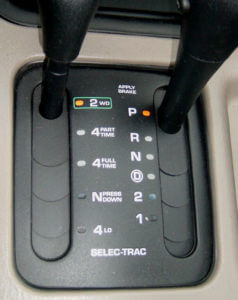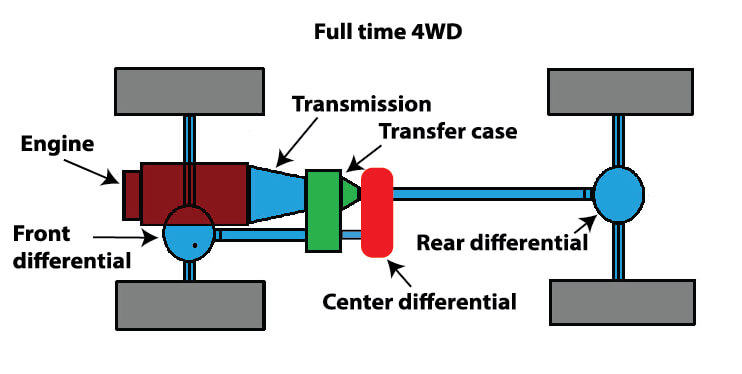Four wheel drive 4WD
The Basics of 4WD: What You Need to Know
Four-wheel drive (4WD) is a feature found in many vehicles, especially trucks and SUVs, designed to enhance traction and handling in various driving conditions. It is particularly beneficial for off-road driving, adverse weather conditions, and challenging terrains. This article explores what 4-wheel drive is, how it works, its different types, and its benefits and drawbacks.
What is 4-Wheel Drive?
4WD is a drivetrain system that powers all four wheels of a vehicle simultaneously. This is different from the more common two-wheel drive (2WD) systems, which power only the front or rear wheels. The primary goal of 4WD is to improve the vehicle’s ability to handle poor road conditions and rough terrains by distributing power to all four wheels, thereby increasing traction.
How 4-Wheel Drive Works
In a 4WD system, power from the engine is distributed to both the front and rear axles, which in turn drive all four wheels. This distribution of power helps maintain better traction in slippery or uneven conditions. The 4WD system typically includes several key components:
Transfer Case: This is a critical part of the 4WD system that splits power between the front and rear axles. It often includes low-range gears for enhanced torque in challenging conditions.
Locking Differentials: These allow for better control of power distribution between the wheels. Locking differentials ensure that both wheels on an axle receive equal power, which is useful in off-road situations where one wheel may lose traction.
Driveshafts: These transmit power from the transfer case to the axles
Types of 4-Wheel Drive Systems
There are several types of 4WD systems, each with its own advantages and suitable applications:
Part-Time 4WD: This system allows the driver to switch between 2WD and 4WD modes. It is useful for vehicles that primarily operate on paved roads but occasionally need enhanced traction for off-road or adverse conditions. The driver can engage 4WD as needed, typically via a lever or electronic switch.
Full-Time 4WD: In this system, all four wheels are driven at all times. Full-time 4WD systems often include a center differential, allowing the wheels to rotate at different speeds, which is essential for smooth turning on dry pavement. This type is ideal for vehicles that frequently encounter varying road conditions.
Automatic 4WD: This system automatically switches between 2WD and 4WD based on driving conditions. Sensors detect wheel slip and engage 4WD when necessary. This type of system offers convenience and ensures that 4WD is used only when needed, conserving fuel.
All-Wheel Drive (AWD): While often used interchangeably with 4WD, AWD systems are typically more refined and designed for on-road use. AWD systems distribute power to all four wheels but usually lack the low-range gearing found in traditional 4WD systems. They are ideal for improving traction and handling on wet or icy roads.
The advantages of 4WD
Enhanced Traction: The primary benefit of 4WD is improved traction, which is crucial for driving on slippery, muddy, or uneven surfaces. By powering all four wheels, 4WD systems reduce the likelihood of getting stuck or losing control.
Off-Road Capability: 4WD is essential for off-road enthusiasts who frequently drive on rough terrains, including sand, rocks, and deep snow. The additional power and control provided by 4WD make navigating these conditions easier and safer.
Increased Stability: In adverse weather conditions such as rain, snow, or ice, 4WD systems provide increased stability by distributing power more evenly among all four wheels.
Disadvantages of 4WD
Higher vehicle cost to buy and maintain. 4WD vehicles cost at least $2,000 more than a comparable 2WD vehicle. In addition, 4WD vehicles require more maintenance and fail more often than comparable 2WD vehicles.
Increased Weight and Complexity: 4WD systems add weight and complexity to a vehicle, which can negatively impact fuel efficiency and require more maintenance.
Fuel Consumption: Operating in 4WD mode can lead to higher fuel consumption, as powering all four wheels requires more energy. This is particularly noticeable in full-time 4WD systems.
When to Use 4-Wheel Drive
While 4WD systems offer significant advantages in certain conditions, they are not always necessary. Here are some scenarios where engaging 4WD is beneficial:
Off-Roading: When driving on trails, sand dunes, or rocky paths, 4WD provides the necessary traction and torque to navigate difficult terrains.
Snow and Ice: In snowy or icy conditions, 4WD helps maintain control and reduces the risk of slipping.
Muddy or Wet Roads: On muddy or waterlogged roads, 4WD improves stability and prevents the vehicle from getting stuck.
What is part-time 4WD?
Part-time 4WD vehicles have a transfer case but no center differential. That’s an important distinction because the front and rear wheels rotate at different rates during a turn. If there’s no center differential and the vehicle is driven on dry pavement, that rotation difference can cause substantial damage to the drive axles. In fact, driving a part-time 4WD vehicle on dry pavement can cause the vehicle to “hop,” bind, break axles, and even destroy the front or rear differential. Part-time 4WD can only be driven safely on snow, ice, or wet roads or in mud or sand where the wheels can slip to accommodate differences in rotation between front and rear differentials.
What is full-time 4WD?
Vehicles with full-time 4WD have a center differential or a viscous coupling that transfers power to the front and rear differentials but still allows for different rotation rates between the front and rear wheels.
What’s the difference between 2-Lo, 4-Lo and 4-High?
2-Lo and 4-Lo gears are designed to deliver maximum pulling power at very slow speeds. You would use either of those gears when pulling a heavy load, like  a boat, out of the water at slow speeds. Obviously, the 4-Lo gear position would provide torque to each of the four wheels, while the 2-Lo gear would only provide torque to two wheels. The 4-high gear position is used when traveling at higher speeds where you want engine power delivered to all four wheels.
a boat, out of the water at slow speeds. Obviously, the 4-Lo gear position would provide torque to each of the four wheels, while the 2-Lo gear would only provide torque to two wheels. The 4-high gear position is used when traveling at higher speeds where you want engine power delivered to all four wheels.
What is shift-on-the-fly?
Older 4WD vehicles require you to stop the vehicle completely before shifting into or out of 4WD mode or shifting between 2-Lo, 4-Lo, or 4-high. Late-model vehicles with shift on the fly allow you to shift into and out of those gears while the vehicle is moving.
Should you buy a 4WD or 2WD?
First, let’s take a look at the difference in price between a brand-new 2WD vehicle versus the same vehicle with 4WD. I’m using a 2017 Ford Fusion SE as the comparison. Both have the 2.0 turbo engine and the same accessory package. Adding 4WD bumps the price by $1,750 and reduces MPG by 2MPG. The lower MPG adds approximately $1,200 to your operating costs every 100,000 due to the lower MPG rating, making the total price at least $2,950 more in the first 100,000 miles, not including increased maintenance and repair costs.
The 2017 Ford Fusion is a front wheel drive vehicle, so one money-saving option is to invest in a set of winter tires and an extra set of wheels and tire pressure sensors. With winter tires, you’ll have slightly less acceleration from a stop than you’d have if it were 4WD. But you’ll have shorter stopping distances and better control in turns due to the winter tires’ better traction. Four winter tires, along with wheels and sensors, cost around $1,000.
So you get almost the same traction leaving stop signs but much better handling in all other driving conditions. Plus, a FWD drivetrain is less costly to maintain and repair. Winter tires save a minimum of $2,000 while giving a better overall performance.
©, 2017 Rick Muscoplat
Posted on by Rick Muscoplat


